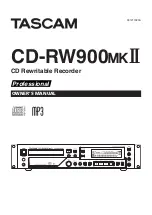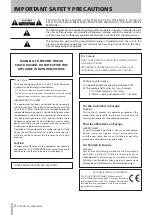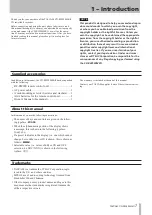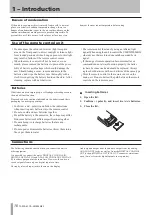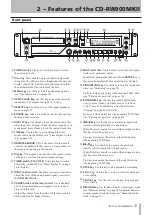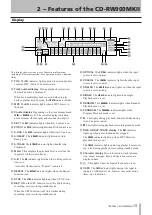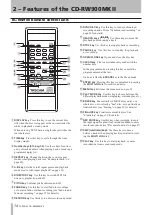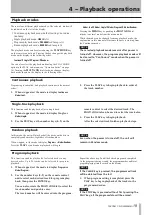
4
TASCAM CD-RW900MKII
Safety Information
8
CAUTIONS ABOUT LASER RADIATION
This product has been designed and manufactured according to
FDA regulations “title 21, CFR, chapter 1, subchapter J, based on
the Radiation Control for Health and Safety Act of 1968,” and is
classified as a class 1 laser product. There is no hazardous invis-
ible laser radiation during operation because invisible laser radia-
tion emitted inside of this product is completely confined in the
protective housings.
The label required in this regulation is shown at
1
.
1
For USA
CERTIFICATION
THIS PRODUCT COMPLIES WITH 21 CFR
1040.10 AND 1040.11 EXCEPT FOR
DEVIATIONS PURSUANT TO LASER
NOTICE NO.50, DATED JUNE 24, 2007.
MADE IN CHINA
Cautions:
•
DO NOT REMOVE THE PROTECTIVE HOUSING USING
A SCREWDRIVER.
•
USE OF CONTROLS OR ADJUSTMENTS OR
PERFORMANCE OF PROCEDURES OTHER THAN
THOSE SPECIFIED HEREIN MAY RESULT IN
HAZARDOUS RADIATION EXPOSURE.
•
IF THIS PRODUCT DEVELOPS TROUBLE, CONTACT
YOUR NEAREST QUALIFIED SERVICE PERSONNEL,
AND DO NOT USE THE PRODUCT IN ITS DAMAGED
STATE.
Optical pickup
Type:
LO-DWH02
Manufacturer:
Lite-space Technology Co., Ltd.
Laser output:
Less than 131.9mW (CD) and 147.8mW
(DVD) on the objective lens
Wavelength:
785nm (CD) typical
661nm (DVD) typical
Standard: IEC60825-1: 2007
8
CAUTIONS ABOUT BATTERIES
This product uses batteries. Misuse of batteries could
cause a leak, rupture or other trouble. Always abide by
the following precautions when using batteries.
• Never recharge non-rechargeable batteries. The
batteries could rupture or leak, causing fire or injury.
• When installing batteries, pay attention to the
polarity indications (plus/minus (+/–) orientation), and
install them correctly in the battery compartment as
indicated. Putting them in backward could make the
batteries rupture or leak, causing fire, injury or stains
around them.
• When you store or dispose batteries, isolate their terminals
with insulation tape or something like that to prevent
them from contacting other batteries or metallic objects.
• When throwing used batteries away, follow the
disposal instructions indicated on the batteries and the
local disposal laws.
• Do not use batteries other than those specified. Do not
mix and use new and old batteries or different types of
batteries together. The batteries could rupture or leak,
causing fire, injury or stains around them.
• Do not carry or store batteries together with small
metal objects. The batteries could short, causing leak,
rupture or other trouble.
• Do not heat or disassemble batteries. Do not put them
in fire or water. Batteries could rupture or leak, causing
fire, injury or stains around them.
• If the battery fluid leaks, wipe away any fluid on
the battery case before inserting new batteries. If
the battery fluid gets in an eye, it could cause loss
of eyesight. If fluid does enter an eye, wash it out
thoroughly with clean water without rubbing the eye
and then consult a doctor immediately. If the fluid
gets on a person’s body or clothing, it could cause skin
injuries or burns. If this should happen, wash it off with
clean water and then consult a doctor immediately.
• The unit power should be off when you install and
replace batteries.
• Remove the batteries if you do not plan to use the unit
for a long time. Batteries could rupture or leak, causing
fire, injury or stains around them. If the battery fluid
leaks, wipe away any fluid on the battery compartment
before inserting new batteries.
• Do not disassemble a battery. The acid inside the
battery could harm skin or clothing.

